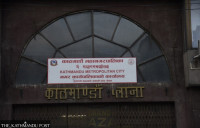Kathmandu
Water mains burst in Lainchaur causes inconvenience to road traffic and pedestrians
The KUKL had on Friday started distributing drinking water, temporarily, to the households of Kathmandu.
Post Report
The bursting of pipe of Melamchi Water Project in Lainchaur on Monday caused inconvenience to the regular traffic and pedestrians in the area.
The earlier leakage in the area later led to a pipe burst during the afternoon and that led to flooding in the area.
“We are updated about the problem, and have already closed water supply to the area,” said Prakash Kumar Rai, spokesperson at the Kathmandu Upatyaka Khanepani Limited (KUKL).
He said the reason for the burst is lack of proper testing of the pipe before the water supply was resumed. “Those pipelines should have been tested before the water was supplied,” said Rai.
The KUKL had on Friday started distributing drinking water supplied by the Melamchi Drinking Water Project, temporarily, to the households of the Kathmandu Valley.
“It was like flooding on the road,” said Rajindra Thapa, 43, a freelance writer who passed through the road on Monday evening. “For pedestrians, it was a nightmare, the authorities should be concerned over such a sensitive issue.”

On Friday, after publishing a schedule, the KUKL had announced that it would distribute Melamchi’s water on alternate days in the Kathmandu Valley.
Malamchi’s water is mostly being distributed through the older piped distribution system.
Since the destructive Melamchi flooding in June last year, it is the second time that the water supplied by the project is being distributed to the Kathmandu residents under a temporary arrangement.
As the headworks of the project continue to remain submerged under the debris brought on by a massive flood in June 2021, it is not certain when the water supply can be arranged permanently.
Under the first phase of the project, the project is supposed to supply 170 million litres per day to the Valley from the Melamchi River in Sindhupalchok.
In the second phase, the project is estimated to fetch 170 million litres of water each from Yangri and Larke rivers, supplying 510 million litres of water daily to the Kathmandu Valley.




 25.87°C Kathmandu
25.87°C Kathmandu









